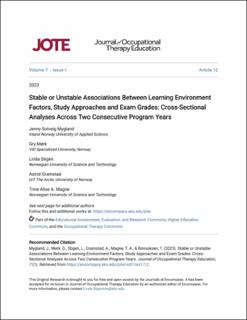| dc.contributor.author | Mygland, Jenny Solveig | |
| dc.contributor.author | Mørk, Gry | |
| dc.contributor.author | Stigen, Linda | |
| dc.contributor.author | Gramstad, Astrid | |
| dc.contributor.author | Magne, Trine A | |
| dc.contributor.author | Bonsaksen, Tore | |
| dc.date.accessioned | 2023-02-10T08:15:42Z | |
| dc.date.available | 2023-02-10T08:15:42Z | |
| dc.date.created | 2023-01-08T12:35:29Z | |
| dc.date.issued | 2023 | |
| dc.identifier.citation | Journal of Occupational Therapy Education. 2023, 7 (1), 1-15. | en_US |
| dc.identifier.issn | 2573-1378 | |
| dc.identifier.uri | https://hdl.handle.net/11250/3049889 | |
| dc.description.abstract | Studies into the relationships between learning environment perceptions, approaches to studying, and academic outcomes have largely followed cross-sectional designs. As a result, knowledge is sparse with regards to whether, or to what degree, the established associations are consistent across years of study. This study aimed to (i) examine associations between occupational therapy students’ academic performance, their approaches to studying and perceptions of the learning environment, while in their second and third years of study, and (ii) evaluate the consistency of the results across years of study. Occupational therapy students in Norway were assessed annually with regards to their perceptions of the learning environment, study approaches, and academic performance. Associations between variables, measured within each study year, were analyzed with linear regression analyses, and then compared year-overyear. In the second study year (n=162), better academic performance was associated with lower student autonomy, and higher scores on strategic approach. In the third study year (n=189), better academic performance was associated with being female and lower scores on surface approach. Having occupational therapy as the preferred line of education at enrollment was associated with better grades in both study years. Associations between grades and gender, perceptions of student autonomy, and study approaches were somewhat different between the two years. Implications for educational practice is discussed and various contents and emphasis in educational programs are proposed. | en_US |
| dc.language.iso | eng | en_US |
| dc.publisher | Encompass, | en_US |
| dc.rights | Attribution-NonCommercial-NoDerivatives 4.0 Internasjonal | * |
| dc.rights.uri | http://creativecommons.org/licenses/by-nc-nd/4.0/deed.no | * |
| dc.subject | occupational therapy education | en_US |
| dc.subject | learning environment | en_US |
| dc.subject | grade point average | en_US |
| dc.subject | approaches to studying | en_US |
| dc.subject | academic performance | en_US |
| dc.title | Stable or unstable associations between learning environment factors, study approaches and exam grades: cross-sectional analyses across two consecutive program years | en_US |
| dc.type | Peer reviewed | en_US |
| dc.type | Journal article | en_US |
| dc.description.version | publishedVersion | en_US |
| dc.rights.holder | This work is licensed under a Creative Commons Attribution-Noncommercial-No Derivative Works 4.0 License. | en_US |
| dc.source.pagenumber | 1-15 | en_US |
| dc.source.volume | 7 | en_US |
| dc.source.journal | Journal of Occupational Therapy Education | en_US |
| dc.source.issue | 1 | en_US |
| dc.identifier.cristin | 2102716 | |
| dc.source.articlenumber | 12 | en_US |
| cristin.ispublished | true | |
| cristin.fulltext | original | |
| cristin.qualitycode | 1 | |

